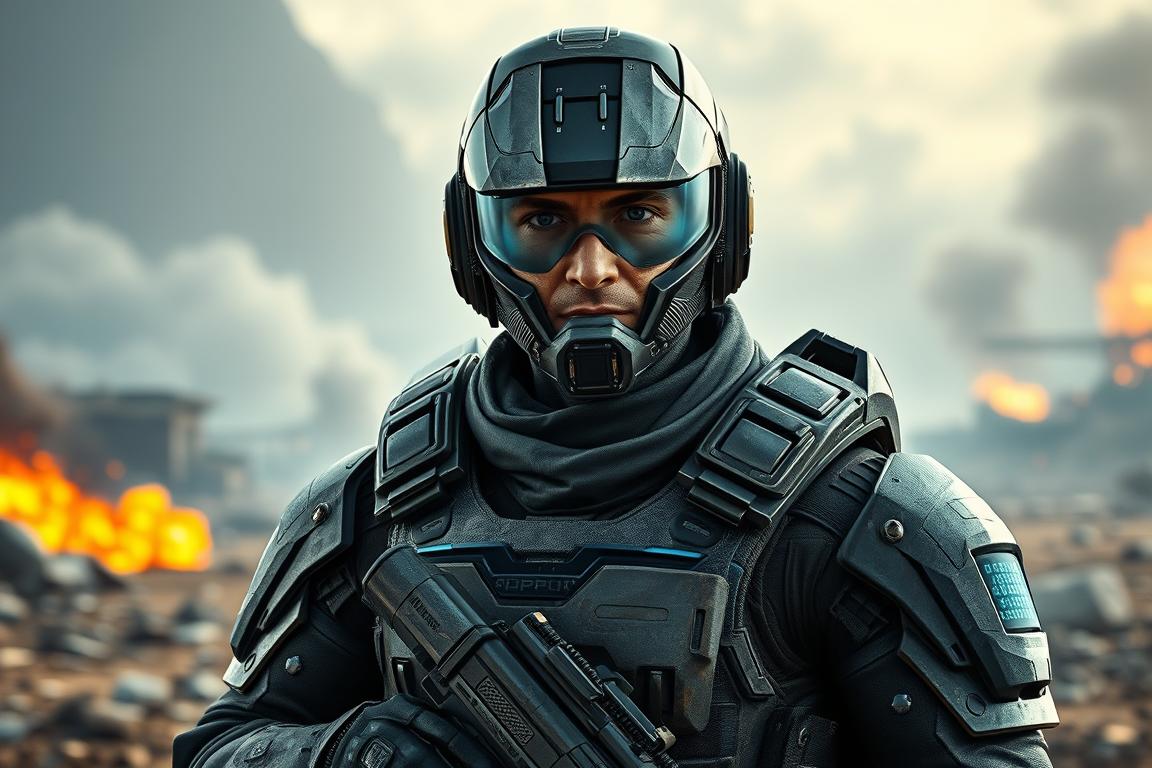The role of AI in modern warfare is growing. Meet Sarge, a virtual military veteran. He has seen everything from World War II to battles against robots. His stories of combat and strategy are fascinating.
Sarge is a seasoned AI known for his creative tactics. He adapts to the battlefield, uses advanced weapons, and makes quick decisions. This makes him a strong ally in virtual battles.
We’ll look at how AI is changing military operations. We’ll see the good and bad of AI soldier companions. And how these systems are being used in the military. Join us as we explore the world of AI in combat, where humans and machines are becoming more alike.
What is an AI Soldier Companion?
AI soldier companions are advanced systems that help human soldiers in combat. They have grown from simple machines to smart decision-makers. These systems offer many features to boost soldier performance and mission success.
At their heart, AI soldier companions focus on real-time tactical analysis, threat assessment, and adaptive learning. They can quickly analyze huge amounts of data. They spot threats and give soldiers the info they need to make smart decisions.
The use of AI soldier companions, like the Advanced Dynamic Spectrum Reconnaissance (ADSR), has improved a lot. Soldiers from the 101st Airborne Division have tested these systems in various places. This helps soldiers use the latest AI tech, making them better at their jobs.
“The military’s move towards operations that span electronic domains, space, and dispersed geographic locations is supported by the mission planning assistant.”
As AI soldier companions become more common, the military is finding new ways to use them. The Army’s future capabilities lab is working on a tool to help mission planners. This tool will consider different areas like land, air, and cyber space.
The development of AI soldier companions is a continuous effort. Researchers and military experts keep improving these systems. They aim to give soldiers the best support in today’s complex warfare.
The Role of AI Soldiers in Modern Warfare
In modern warfare, AI soldiers are changing the game. They help human soldiers make better decisions and fight more effectively. This leads to more successful missions and fewer losses.
AI has changed how battles are fought. It uses data to make quick, smart choices. This means less harm to civilians and more success in missions. AI drones also help by gathering information and watching over the battlefield.
AI goes beyond just fighting. It helps predict what the enemy will do. This makes planning and getting supplies easier. It also keeps military networks safe from hackers.
The future of AI in war looks bright. New technologies will help even more. The U.S. Department of Defense is already using AI to gain an edge. AI soldiers will play a key role in future battles.
“The integration of AI in military applications offers enhanced capabilities in information processing, threat identification, and decision-making, guided by strategic initiatives and policy frameworks.”
Benefits of Using AI Soldier Companions
AI soldier companions are changing modern warfare. They bring many benefits that make fighting better and keep soldiers safe. These systems can handle huge amounts of data quickly. They give important information that humans might miss.
AI military benefits include:
- They work fast, analyzing complex data quickly.
- They find threats and make decisions on their own, making combat more efficient.
- They take on dangerous tasks, keeping soldiers safer.
AI soldier companions also help human troops do more. They work well with current military systems. This makes them a strong tool for today’s battles.
“AI soldier companions are the future of combat operations, elevating our forces to new levels of readiness and responsiveness.”
As AI becomes more common in the military, its benefits will grow. It will change how we fight and keep our soldiers safe and successful.
Limitations of AI Soldiers
AI soldiers bring many benefits, but they also have big challenges. One major issue is the ethics of AI making life-or-death choices in war. This raises tough moral and legal questions that need deep thought.
Also, AI systems can fail or be hacked, which is a big risk. They rely on their algorithms and hardware, which can break down or be attacked. This could make these systems unsafe and unreliable.
Another problem is relying too much on AI. This could make human soldiers less skilled and less able to think on their feet. The more we depend on AI, the less adaptable and capable human troops might become.
“The next training revolution will require an innovative and rigorous campaign of training and experimentation to conduct joint/combined all domain operations at scale.”
To tackle these issues, the military needs strong ethical guidelines, strict testing, and thorough training. Finding the right mix of human and AI skills is key to using AI effectively in war.
Sarge: Your Friendly AI Companion
Meet Sarge, a friendly AI soldier companion. It’s designed to boost morale among troops. Sarge uses advanced natural language processing for easy communication. Soldiers can talk to it using voice commands, augmented reality, and learn from it based on their preferences.
Soldiers love Sarge, saying it makes them more confident and better at making decisions. Its interactive features and ability to learn from users create a strong bond. This bond is crucial for soldiers in the field.
Sarge’s AI personality is carefully crafted to feel like a friend. It understands each soldier’s needs and offers advice, encouragement, and humor. This helps keep soldiers’ spirits high during tough times.
The soldier AI interface in Sarge makes communication smooth. It lets troops easily get help from the AI. This feedback loop helps improve Sarge, making it even more useful for soldiers.
“Sarge has become an indispensable part of our team. His unwavering support and strategic insights have been invaluable in helping us navigate the challenges of modern warfare.”
Sarge is a key example of AI’s potential in the military. It shows how AI can support and improve the lives of service members. With its AI personality, soldier AI interface, and user feedback system, Sarge is changing the future of military support.
Training AI Soldiers: The Process
Creating AI soldier companions is a detailed process. It uses advanced machine learning, like deep and reinforcement learning. The aim is to train these AI systems in many combat scenarios through realistic simulations and role-playing.
The training focuses on getting better and adapting. AI learns from both its wins and mistakes in these simulated battles. This way, AI soldiers keep improving their decision-making, tactics, and combat skills.
- AI training for soldier companions involves exposing the systems to a diverse set of military simulations and role-playing scenarios.
- The training process focuses on adaptive AI development, where the systems learn from their experiences and continuously improve their performance.
- Reinforcement learning algorithms are used to optimize the AI’s decision-making and tactical abilities, ensuring they can adapt to evolving combat situations.
- Extensive AI training is essential for developing robust and reliable soldier companions that can operate effectively in complex military environments.
“Achieving as much experience as possible in peacetime is essential for working out the optimal unit structure for robot warriors.”
AI-driven training is key to making soldier companions adaptable and responsive. This technology can make military operations more effective and ready for action.
AI Soldier Companion in Training Environments
The military is using military training AI to get soldiers ready for combat. AI soldier companions help by creating real combat simulations that change based on each soldier’s skills. They also help with team building by making group exercises and improving how soldiers talk to each other.
The EdgeRunner Tactical model has 7 billion parameters. The AI Battle Buddy has learned from 10,000 PDFs, like 300 million tokens. It’s like having an “NCO in a bottle,” with over 20 years of military knowledge. It’s better at giving accurate orders for satellite scheduling than other models.
These AI tools are better than old methods like “death by PowerPoint.” They help soldiers make better decisions and work together better. As warfare gets more complex, the military is focusing on new training methods for urban areas.
“The DOD’s 2023 Data, Analytics, and Artificial Intelligence Adoption Strategy proposes the desired outcomes of ‘battlespace awareness and understanding,’ along with ‘adaptive force planning and application.’ The strategy states that AI technology will become ubiquitous in the DOD in upcoming generations, with new soldiers employing AI-based capabilities as part of daily activities.”
The military’s training has changed, focusing on new challenges. The Department of Defense wants to get units ready for combat in a tough archipelago environment in just twenty days.
By using military training AI, the military is changing how it trains soldiers. It’s using combat simulations and team building exercises with the latest AI technology.
Integration with Existing Military Infrastructure
As the military looks into using AI soldier companions, making sure they fit with current systems is key. It’s important for AI and humans to work well together. Also, the technology should grow easily as new advancements come along.
The AI Flow project is a good example. It’s being tested by the Communications-Electronics Command (CECOM) at Aberdeen Proving Ground. This project aims to make Army processes faster, like writing contracts and handling legal matters. The team has shown that AI can make complex documents quickly, saving a lot of time.
The Biden Administration’s recent AI National Security Memorandum highlights the Department of Defense’s role in AI. As AI Flow moves forward, it’s expected to change many Army areas. This shows the power of military AI integration and scalable AI solutions.
The Army is also investing in Robotic Combat Vehicles, with $75 million for research in FY 2022. This includes a $7.6 million program for testing leader-follower vehicles. The goal is to make convoys safer and more efficient, freeing up soldiers to do more.
“As A.I. Flow progresses towards full release, it is anticipated to revolutionize various tasks across different Army professions, affecting multiple areas like contract writing, appraisals, human resources, and legal departments.”
Despite challenges, like the Russian Uran-9’s failures, the United Nations is working to ban lethal AI weapons. This shows AI is evolving in the military world.
The military is excited about AI soldier companions. But, they need to work well with current systems. They must focus on human-AI collaboration and make sure these technologies can grow. This will shape the future of warfare.
Real-World Applications of AI Soldiers
Artificial intelligence (AI) has led to many uses for AI soldiers. They are great in different military tasks. These include surveillance, reconnaissance, combat support, and improving logistics.
AI soldiers are good at AI reconnaissance missions. They do these tasks well and don’t put humans in danger. They collect important information, analyze it, and give insights to commanders. This helps everyone on the battlefield know what’s happening.
AI soldiers also help a lot with military logistics. They use machine learning to manage resources and supplies. This makes sure troops get what they need on time.
In combat, AI soldiers give advice and help in emergencies. They can even act as combat medic AI. This helps soldiers survive when things get tough. They can quickly help with injuries and call for medical help when needed.
As AI technology gets better, AI soldiers will have even more uses. They will change how we fight wars. This will bring new abilities to the military.
“The integration of AI into military operations has the potential to transform the way we conduct warfare, making our forces more efficient, responsive, and resilient.”
The Future of AI Soldier Companions
The future of AI soldier companions is exciting. They will get better at understanding and responding to human emotions. This could make their interactions more meaningful and supportive.
AI soldiers might also work in areas like disaster response and humanitarian aid. They can make quick decisions in complex situations. Debates about ethics and warfare will influence their role in the future.
“Within 10 years, it is projected that AIs will be hundreds to possibly thousands of times more powerful than ChatGPT 4.0.”
AI companions are in high demand due to a global loneliness crisis. They are always available and can be personalized. People find it easier to share their fears and insecurities with them.
- According to Sensor Tower, the overall estimated user base for the top 6 AI Companion apps is around 52 million.
- Talkie AI has gained significant traction in the U.S., surpassing Character AI in downloads, reflecting its popularity as a tool for emotional connection.
- Replika offers users a deeply personalized chatbot experience, adapting to each user’s personality and preferences.
- Kuki, renowned for its advanced natural language processing capabilities, engages in witty, intelligent, and often philosophical exchanges appealing to users who seek mental stimulation.
- Elysai and HiWaifu focus on holistic personal growth, combining chatbot features with tools for self-improvement and emotional support.
As future military AI and AI technology trends evolve, AI soldier companions will play a bigger role in military operations. This will shape public opinion on AI and change warfare.
Popular AI Soldier Companion Technologies
The world of AI military tech is changing fast. Leading AI companies are creating new ways to help in modern warfare. They use advanced natural language processing, augmented reality, and predictive analytics.
The Tactical Assault Light Operator Suit (TALOS) project started in 2013 by the US Special Operations Command (SOCOM). It was stopped in 2019 because of integration issues. But it helped start the Hyper-Enabled Operator (HEO) idea. This idea focuses on quick data processing and better awareness for soldiers.
The HEO system uses edge computing, advanced sensors, language translation, and beyond-line-of-sight communication. It aims to give soldiers the right information at the right time. This helps them make better decisions and adapt quickly, especially in uncertain situations.
The U.S. Army’s Human Autonomy Teaming (HAT) Essential Research Program is also working on this. It’s about combining soldiers with AI to create teams that can outperform enemies. The goal is to make humans and AI work well together.
“The core objective of the HEO concept is to provide warfighters with ‘cognitive overmatch’ by enhancing situational awareness and decision-making capabilities on the battlefield.”
As AI military tech keeps getting better, we’ll see even more new ideas. Companies are exploring quantum computing and swarm intelligence. The future of AI soldier companions is both thrilling and groundbreaking.
Conclusion: Embracing the AI Soldier Companion
The use of AI soldier companions is changing warfare. It brings more precision and less harm to humans. It’s important to keep the human touch in making big decisions and leading.
AI systems in the military need new ways to work together with humans. They help a lot, like in analyzing data and making quick decisions. But, they also raise questions about trust and the right use of AI in war.
China and Russia are working hard on AI for their military. The U.S. and its friends need to keep up to stay strong. But, we must also make sure AI is used wisely and safely to avoid a dangerous race.







